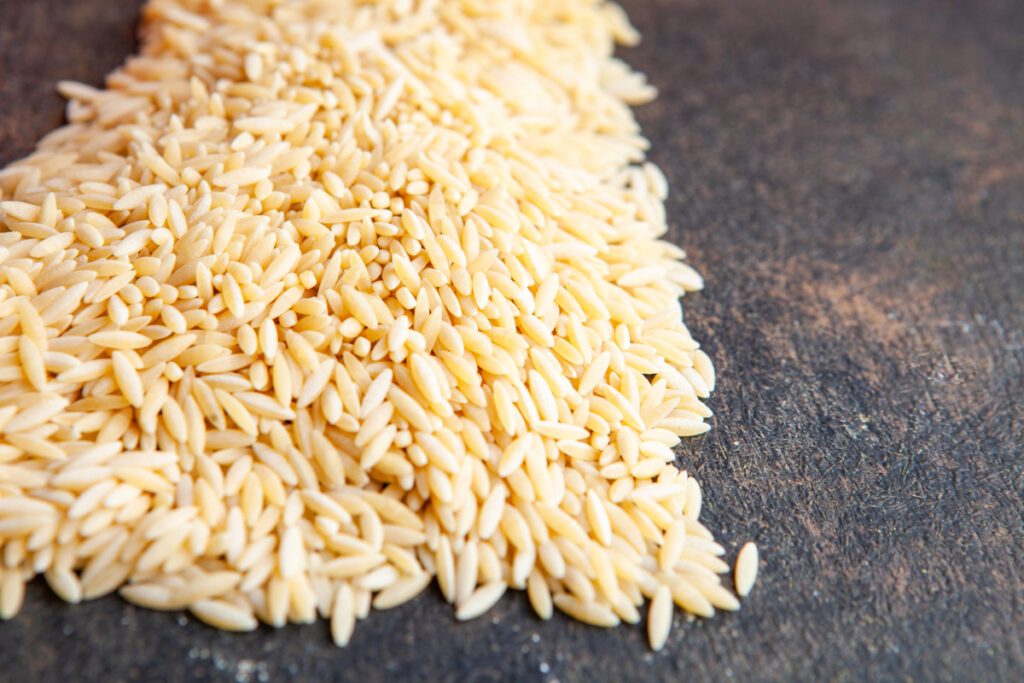What makes orzo unique? This rice-shaped pasta stands out for its versatility, tender texture, and ability to absorb flavor beautifully. Widely used in Mediterranean and Italian cuisines, orzo shines in salads, soups, casseroles, and even creamy risotto-style dishes. In this article, we’ll explore what makes orzo unique by looking at its ingredients, cooking methods, nutritional benefits, and variations like whole grain or gluten-free options.

Many home cooks ask, what makes orzo unique compared to other small pasta shapes like couscous or rice.
Table of Contents
What Exactly Is Orzo?
Orzo is a type of pasta made primarily from durum wheat semolina flour. Despite its rice-like appearance, orzo is pasta and not a grain. Its name, derived from the Italian word for “barley,” reflects its shape, which resembles small grains of barley or rice. Orzo is prized for its ability to absorb flavors and its soft but firm texture, making it a favorite in many dishes.
For a delicious way to incorporate orzo into your meals, try this Marry Me Chicken Orzo recipe, which highlights its creamy texture.
To fully understand what makes orzo unique, it’s helpful to look at both its texture and how it’s traditionally used in Mediterranean dishes.
Exploring Orzo’s Mediterranean Roots
Orzo’s history is deeply intertwined with Mediterranean cuisine. In Greece, kritharaki is a traditional pasta used in dishes like giouvetsi, a flavorful stew with lamb or beef. Italians often add orzo to soups like minestrone or use it in broths. Its ability to mimic rice made orzo a staple in many cultures, offering chefs a versatile ingredient that enhances both taste and texture.
Curious about how orzo compares to other staples? Check out Is Orzo Healthier Than Rice? for a detailed comparison.
Ingredients That Make Orzo Unique
Manufacturers make traditional orzo using semolina flour, a high-protein flour derived from durum wheat. This key ingredient gives orzo its firm structure and ability to hold its shape during cooking.
Variants of Orzo:
- Whole-Grain Orzo: Made from whole durum wheat, offering higher fiber and nutrients.
- Gluten-Free Orzo: Crafted from rice, quinoa, or corn flour, catering to those with gluten sensitivities.
For expert tips on choosing the right orzo for your diet, explore Good Housekeeping.
Orzo’s Nutrition Facts and Health Benefits
Macronutrients
- Calories: About 200 per cooked cup.
- Carbohydrates: Provides 40 grams per serving, making it a rich source of energy.
- Protein: Each serving contains 6 grams of protein, supporting muscle health.
Micronutrients
- Iron: Essential for oxygen transport in the body.
- B Vitamins: Important for energy metabolism and overall cell function.
Whole-grain orzo provides additional fiber and minerals, making it a healthier option for individuals looking to improve digestion and satiety.
Can You Find Gluten-Free Orzo?
Traditional orzo contains gluten, but gluten-free options are available for those with dietary restrictions. These versions use alternative flours such as:
- Rice Flour
- Quinoa Flour
- Corn Flour
These substitutes retain orzo’s texture while catering to gluten-free diets. For more on gluten-free eating, check out Healthline.
The Process of Making Orzo Pasta
The process of making orzo is similar to other pasta:
- Mixing Ingredients: Producers combine semolina flour and water to form a firm dough.
- Shaping the Pasta: They shape the dough into small, rice-like pieces using extrusion.
- Drying or Selling Fresh: The shaped orzo is dried for longer shelf life or sold fresh.
Homemade orzo allows chefs to experiment with alternative flours and customize the texture.
One key factor in what makes orzo unique is its ability to blend seamlessly into both hot and cold recipes.
Step-by-Step Guide to Cooking Orzo
Cooking orzo is simple, making it a convenient addition to meals. Here’s how to prepare it perfectly:
- Boiling: Cook orzo in salted boiling water for 8–10 minutes until al dente.
- Simmering in Broth: Add orzo directly to soups or stews for enhanced flavor.
- Baking: Use orzo in casseroles, combining it with cheese, vegetables, and a creamy sauce.
Pro Tips:
- Rinse cooked orzo under cold water to remove excess starch and prevent clumping.
- Toast orzo before boiling to add a nutty flavor.
For more cooking inspiration, visit AllRecipes for detailed instructions and creative recipes.
From its smooth mouthfeel to its quick cooking time, there are several things that highlight what makes orzo unique.
Delicious Recipes Featuring Orzo
Orzo is a star ingredient in a variety of dishes. Some popular recipes include:
- Mediterranean Salads: Toss cooked orzo with olives, cherry tomatoes, and feta for a refreshing salad.
- Soups: Add orzo to chicken soup or vegetable broth for added texture and substance.
- Casseroles: Bake orzo with spinach, cheese, and roasted vegetables for a comforting dish.
If you’re still wondering what makes orzo unique, just try it in a lemon herb orzo salad and taste the difference.
For plant-based ideas, try the Marry Me Chickpeas Recipe, which pairs beautifully with orzo.
FAQs
1. What type of pasta is orzo?
Orzo is a small pasta made from semolina flour and shaped like rice grains.
2. Can orzo replace rice in recipes?
Yes, orzo works well as a substitute for rice in pilafs, risottos, and grain-based salads.
3. Is orzo healthier than couscous?
Whole-grain orzo contains more fiber and nutrients than couscous, making it a better option for digestion and satiety.
4. What’s the best way to prepare orzo for salads?
Cook orzo al dente, rinse it under cold water, and toss it with olive oil to prevent sticking.
Sustainability and Orzo
Durum wheat, the primary ingredient in orzo, is a relatively sustainable crop when grown responsibly. Choosing organic or locally sourced brands can reduce its environmental footprint. Gluten-free alternatives made from quinoa and rice are also eco-friendly options.
Final Thoughts: Why Orzo Belongs in Your Pantry
Orzo’s unique combination of flavor, texture, and versatility makes it a staple for home cooks. Whether you’re preparing a simple salad, a comforting soup, or a hearty casserole, orzo adapts beautifully to a variety of cuisines. With whole-grain and gluten-free options available, it’s a suitable choice for diverse dietary needs.
